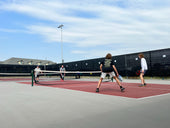While pickleball is a simple sport, it has its own set of rules that can be a little confusing since they differ from other sports like tennis. One of those confusing pickleball rules is the double bounce rule.
It’s also known as the 2-bounce rule, and if you’re wondering what this rule is all about, you’ve come to the right place!
In this article we’ll describe the double bounce rule in pickleball and provide examples of correct and incorrect play involving the rule in both singles and doubles.
Our goal is to make it easy for you to remember the 2 bounce rule the next time you are on the court!

What is the Double Bounce Rule in Pickleball?
The double bounce rule is one of the most important pickleball rules that you’ll need to learn as a beginner, as it governs how points are started with the return of serve and what’s called the 3rd shot in pickleball (the shot after the return of serve).
According to the double bounce rule, after the initial serve by the serving team starts the point, the return team must let the ball bounce before hitting the 2nd shot. The serving team then needs to let the next shot (the 3rd shot in the rally) bounce before striking the pickleball. Specifically, this means the serve, return of serve, and the third shot must bounce (i.e., no volleying) before being struck by a paddle. In other words, after the serve is struck to start the point, each team/player must make 1 groundstroke before they can volley the pickleball out of the air.
The following definitions will come in handy and help you understand the double-bounce pickleball return rule better.
- Groundstroke: Pickleball paddle contacting the ball after 1 bounce.
- Volley: Hitting the ball in the air before it hits the ground.
Here’s a sequence of steps to explain the 2-shot rule in pickleball in detail.
- The serving team/player serves the ball.
- The receiving team/player must let the ball hit the ground for 1 bounce before making the return of serve (second shot, first bounce).
- Then the serving team must let the ball bounce (1 time) before making the shot (third shot, second bounce).
- Once the above steps are completed, as the ball has bounced twice (once on each side of the court), players are now free to make groundstrokes or volley the ball.
Therefore, you can say that the pickleball double bounce rule only applies to the following shots.
- Second shot: Return of serve by the receiving team
- Third shot: First shot by the serving team after the serve
It’s one of the most important pickleball return rules, which is intended to prevent players from hitting the ball in the air or rushing the net and creating an unfair advantage early in the point/rally.
Double Bounce Rule Examples
Let’s discuss some double-bounce rule examples while playing pickleball, singles, and doubles.
Double Bounce Rule Examples - Pickleball Singles
If you’re playing pickleball singles, keep the following examples in mind. It’ll help you remember the two-bounce rule.
While Serving
If you need to serve the ball, you’ll need to stay close to the baseline after making the serve shot because you’ll need to let the ball hit the ground in front of you against the return of serve.

If you move toward the net right after serving, the risk of getting caught in a bad spot will become higher, especially if the other player makes a deep “return of serve” shot near the baseline.
You’ll lose a point if you use your paddle to contact the ball on the return of serve before letting it bounce.
It’s important to note that the first bounce part of the two-bounce rule is common in other sports, such as tennis, but the second bounce part is not, making it a bit more problematic for the server.
While Receiving Serve
One of the easiest ways to remember the pickleball two-bounce rule while playing singles is to stand behind the baseline when you’re expecting the serve from the other player/team.
You can even stand several feet behind the baseline if the server on the other side makes deep serves.
This way, you’ll be less tempted to hit the ball before it hits the ground and it’ll minimize the risk of losing a point. Once you have made the return of serve, you’ll immediately want to advance toward the net, as you’ll now be free to start volleying.
If you hit the ball before it touches the ground, you’ll lose a point.
Double Bounce Rule Examples - Pickleball Doubles
The following examples will help you with the double bounce rule while playing pickleball doubles.
While Serving
If you’re on the serving team, you and your partner will need to start behind the baseline. It’ll help you both let the ball hit the ground for the second time once the other team has made the return of serve.
If you’re hitting the serve, you’ll need to remind your partner to stay behind the baseline as you initiate the serve. That’s because your partner will have more time to advance toward the net than you.
So, they’ll also be more susceptible to getting caught by the double bounce rule, and if they fail to let the ball hit the ground on the return of serve, you’ll lose the point.
While Receiving Serve
If you’re receiving the serve, your partner can stand in the non-volley zone, as they’ll only be able to hit the 4th shot. However, they’ll need to make sure that they don’t intercept the ball on the serve.
Once you have made the return of serve, your partner can be as aggressive as they want to play the 4th shot.
Why is There A Two-Bounce Rule in Pickleball?
Now that you understand how to abide by the two-bounce rule, let’s discuss why it’s there in pickleball in the first place.
As mentioned earlier, this rule is designed to prevent players/teams from volleying to create an unfair advantage early in the point/rally.

The double bounce rule ensures that players of all skill levels and ages can play a shot for each point. In the absence of this rule, it’ll become much easier for skilled players/teams to dominate their opponents by scoring an easy point early.
Not only will it lead to shorter games, but it’ll also eliminate the thrill and fun of pickleball. While some people may think that the two-bounce rule makes for an unfair way to eliminate a volley and serve advantage, it ensures longer rallies.
It allows the game to transition smoothly and provides each team with enough time to apply a strategy.
What is the Official Double Bounce Rule from USA Pickleball?
According to the official USA pickleball rulebook, each player/side/team must make one groundstroke before they can start volleying the ball.
Once the ball has bounced once on each side of the court, both players/sides/teams can make a groundstroke or hit the ball before it bounces.
Before 2018, the USA pickleball rulebook used to label this rule as the “Double Bounce Rule.” However, the latest version of the rule book contains the “Two-Bounce Rule” wording for the same rule.

Pickleball Double Bounce Rule Summary
Many pickleball rules are similar to tennis and ping pong, but the double-bounce or two-bounce rule is an exception. It’s not a complex rule to understand, and following this rule becomes the way you play the sport once you understand how it works.
We hope this guide has helped you understand what the double-bounce rule is so that you can remember it while playing.
FAQs: Double Bounce Rule in Pickleball
Can the Ball Bounce Twice on 1 Side in Pickleball?
No, the ball cannot bounce twice on one side of the court in pickleball. If that happens, the point is over, and the team standing on the double-bounce side will lose the point.
Can the Second Bounce (the return of serve) be in the Kitchen?
Yes, the second bounce or the return of serve can legally land in the kitchen. However, it’s not the best place for the ball to land on the return of serve, from a strategic perspective, as it’ll make it easy for the serving team to collect the ball and play an aggressive shot.
Are the Two Bounce Rule and Double Bounce Rule the Same in Pickleball?
Yes, the two-bounce and double-bounce rules are the same in pickleball. The official USA pickleball rule book used “Double Bounce Rule” wording. But in 2018, the name of the rule was changed, and the rulebook now uses “Two-Bounce Rule” wording for the same rule.
Is the Double Bounce Rule the Same in Pickleball Singles and Doubles?
Yes, the double bounce rule is the same in pickleball singles and doubles. The ball must hit the ground in the second and third shots after the serve.
Does the Return of Serve in Pickleball Have to Clear the Kitchen?
No, the return of serve in pickleball doesn’t have to clear the kitchen, as per the rules. However, it’s best to play the return of serve deep from a strategic perspective. It’ll make it difficult for the serving team to play such a return of serve.
Pickleball Double Bounce Rule Infographic:




